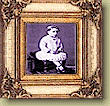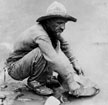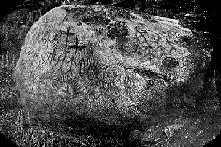

Panning for Gold

Faces of the Gold Rush

What's the meaning?

You be the Judge...

Thompson River First Nations


|

Thompson River First Nations Collection:
Rock Painting
 |
| (Click on image to see enlargement!) |
(Source: A Rock Painting of the Thompson River Indians, British Columbia, by James Teit. Author's Edition, extracted from the Bulletin of the American Museum of Natural History, vol. VIII, Article XII, pp 227-230. New York, November 20, 1896. Housed in the British Columbia archives, Victoria. Accession number: NWp 970.68 T268)
Article XII.-A ROCK PAINTING OF THE THOMPSON RIVER INDIANS, BRITISH COLUMBIA.
BY JAMES TEIT.
Edited, from notes of the collector, by Franz Boas.
In the interior of British Columbia numerous rock paintings are found, most of which are laid on in red ochre. Many of these have the appearance of having been made quite recently. Mr. James Teit has had the good fortune to find one near Spence's Bridge, B. C., which the Indians were able to explain in detail.
According to the custom of the Thompson River Indians, who form a branch of the Salishaw family, girls on reaching maturity must retire to the hills where they undergo a long ceremony of purification and make offerings to secure good luck. At the end of this period they record their offerings and the ceremonies that they have performed on a boulder. The subjects of these records are therefore identical in many cases, and all the women of the tribe are able to interpret their meaning. Mr. Teit found a boulder of this sort near Skait6k, about one mile northeast of Spence's Bridge. It is partly imbedded in the ground and faces northward and southward. The paintings are all on the south side. The size of the boulder is about six feet square, and it rises to a height of four feet above the ground. The paintings occupy a space about 5 1/2 feet by 4 feet in size.
The explanations were given by Waxtko, an old woman living at Spence's Bridge. In giving her explanations she stated that she had made paintings of the same character when undergoing the ceremonial of purification at the time when the reached maturity, and that she was perfectly familiar with the meanings of all the designs. According to her statement the paintings were made by various girls at the time when they reached maturity. This is borne out by the appearance of the paintings, some of which are quite fresh while others appear old and indistinct.
In order to facilitate description I have numbered the paintings, and when it seemed desirable, separated the individual figures by broken lines.
- FIG. 1.-The crossing of two trails. At such places girls used to bury part of the food they were given after having fasted four days at the beginning of the period of purification.
- FIG. 2.-Crossing of trails ; see Fig. 1.
- FIG. 3.-Four fir branches, such as the girl had to deposit at the entrance of her lodge, which was built of three or four fir branches. The horizontal line connecting the three branches at the left hand side indicates that they were placed near each other.
- FIG. 4.-A fir branch the needles of which have been plucked off ; used as an offering. The girls pluck the needles one by one, that their fingers may become nimble, and that they may not grow tired by the work that will be her share in life.
- FIG. 5.-A girl's lodge, made of fir branches. The lower portion of the figure up to the dotted line represents fir branches that hang down from the roof of the lodge. The girl plucks the needles from these one by one. The top of the figure represents the roof of the lodge, or the fir branches placed in front of the entrance, like FIG. 3.
- FIGS. 6, 7, 8.-Crossitig of trails ; see FIG. 1.
- FIG. 9.-A fir branch; see FIG. 3.
- FIG. 10. The explainer was in doubt if this figure was a poor representation of a fir branch -it will be noticed that the short central line at the base is missing- or if it meant a trench with a fir branch at each end. Girls used to dig trenches in order to attain skill and endurance in digging roots and doing hard work of all kinds.
- FIG. 11. -The cross lines on top of this figure and the two downward lines to the right represent the roof of a fir lodge. The long line with the short diverging lines at its lower end represent the roof of a fir branch which is suspended from the roof of the lodge, the needles of which have been plucked off; see FIG. 5.
- FIG. 12.-A snake, which had probably formed the subject of one of the girl's dreams.
- FIG. 13.-The two long lines which cross at right angles represent the crossing of trails. The four short lines which run downward from the horizontal line represent four sticks that are placed at the crossing as an offering. The longer line to the right with its two diverging branches represents a fir branch that is also placed at the crossing.
- FIG. 14.-The unfinished edge of a mat or of some other kind of basketry work. Girls had to make, during the period of isolation, small mats and baskets in order to become expert in this line of work. The painting represents work of this kind that the girl has done.
- FIG. 15.-Crossing of trails; see Fig. 1.
- FIG. 16.-Either two trenches (see Fig. 10), or two sticks given as an offering, or simply the numeral two (2) having reference to the snake (Fig. 12), or to another of the surrounding figures.
- FIG. 17.-A fir branch; see Fig. 3.
- FIG. 18.-The unfinished edge of a mat; see Fig. 14.
- FIG. 19.-An animal, probably a dog, which had formed the subject of one of the girls' dreams.
- FIG. 20.-A fir branch ; see Fig. 3.
- FIG. 21.-A fir branch; see Fig. 3.
- FIG. 22.-An animal, probably a dog, which had formed the subject of one of the girls' dreams.
- FIG. 23.-The unfinished edge of a mat; see Fig. 14.
- FIG. 24.-A fir branch; see Fig. 3.
- FIG. 25.-The upper part of this figure represents the crossing of trails. The branches farther down represent fir branches set up as offerings at the crossing.
- FIG. 26.-The unfinished edge of a mat; see FIG.14.
- FIG. 27.-A fir branch; see Fig. 3.
- FIG. 28.-Either a fir branch or an imperfect representation of a fir lodge.
Home | Contents | Tour | People | Collection |
Transportation | Just For Kids! | Team
|








